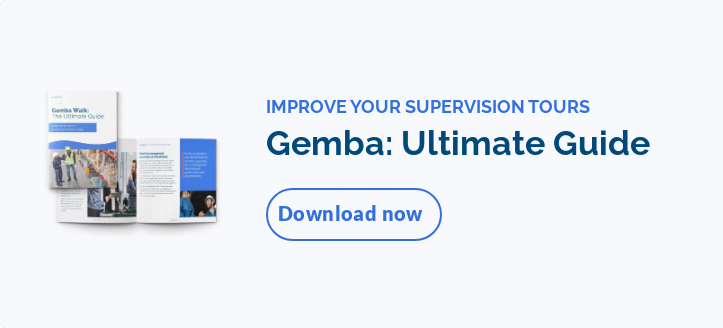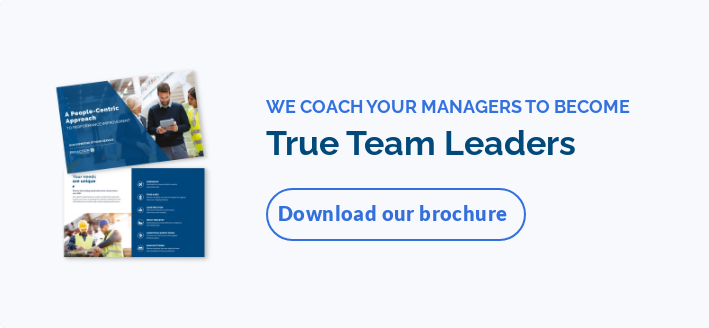What is coaching kata?
The term "kata" originates from Japanese martial arts, and refers to repeated movements and techniques to master a specific skill.
In the context of Lean Management, a kata refers to a routine or behavior practiced to develop skills and a mindset of continuous improvement. Through repetition, each kata becomes a habit, a reflex.
Mike Rother popularized the concept of “coaching kata” in the book Toyota Kata. He emphasizes the importance of deliberate routines to foster a culture of continuous improvement – a practice originally observed among Toyota employees. Their structured way of learning and adapting through daily routines became the Toyota kata, the foundation for what would later become improvement kata and coaching kata.
Coaching kata vs. improvement kata
An improvement kata focuses on the learner’s routine of experimentation and progress toward a target condition. It helps develop problem-solving capabilities.
A coaching kata is a structured approach used by the coach to guide the learning process implemented through the improvement kata. It ensures that learning is consistent, deliberate, and aligned with organizational goals.
Both improvement kata and coaching kata establish a problem-solving culture, supporting continuous learning and operational excellence.
The dojo in coaching kata
The term "dojo" means "place of the Way" in Japanese and refers to a space dedicated to learning and practice. In the context of coaching kata, the dojo is a training ground where managers and teams can experiment, learn, and master the practices of improvement kata through specific iterative cycles.
A key tool for frontline managers
The coaching kata is primarily for frontline managers, who are the leaders in direct contact with operations and teams. It is very effective for strengthening:
- Decision-making and problem-solving skills based on observations and data collected on the plant floor.
- Continuous improvement by regularly identifying gaps and testing different solutions.
- Coaching and leadership by providing a clear and reassuring framework for teams, and teaching managers to develop new skills.
- Change management by encouraging employees to adopt new ways of doing things and encouraging managers to approach challenges positively.
- Management vision by ensuring a shared understanding of objectives and priorities.
Benefits of coaching kata for successful Lean Management implementation
Coaching kata plays a vital role in Lean Management by fostering organizational transformation. It helps to:
- Align theory and practice.
- Develop managers' coaching skills.
- Promote learning by doing.
- Strengthen a culture of continuous improvement.
- Improve employee engagement and well-being.
- Facilitate consistent process improvements through structured learning cycles.
The role of the coach in coaching kata
Beyond providing knowledge, the coach’s role is to act as a guide and facilitator in the learning process. They support the learner on their journey, helping them gain perspective, analyze situations, ask the right questions, and engage in repeated learning cycles.
The coach and the learner work hand in hand toward a shared goal – sustainably and autonomously integrate improvement routines into daily life. The coach supports, observes, questions, and listens. The learner plans, acts on the floor, and adjusts as needed. These two actors depend on each other.
Manager’s duties as a coach
- Guide and support: The coach provides support and guidance to their employees throughout the improvement process. They must give direction, suggest ideas, and ensure that team members involved fully understand the objectives and principles of the kata.
- Teach routines: Kata principles are at the heart of the coaching kata. So you must teach these reflexes to learners, emphasizing problem-solving and improvement. Explain each routine's steps, techniques, and actions, ensuring that employees understand the basics.
- Promote continuous improvement: To foster a culture of continuous improvement, encourage employees to repeat their practices. Help them identify incremental enhancements, find new ideas, and experiment with different approaches.
- Empower employees: As a coach, one of your goals is to develop learner autonomy. Start by giving them clear instructions, then let them find improvement solutions. This will help build accountability and confidence to tackle challenges independently.
- Cultivate a growth mindset: Encourage learners to view challenges as learning opportunities, embrace experimentation, and remain open to new approaches.
Best practices for a successful coach-learner relationship
Establish a trusted relationship
A good relationship between the coach and learner is the pillar of coaching kata's success. A relationship of mutual trust allows the learner to feel comfortable sharing their challenges, doubts, and successes. The coach must demonstrate active listening and empathy, be available, and fully commit to the learner's development. Through such relationships, coaching becomes truly effective, enabling constructive and honest dialogues.
Practice good communication
Good communication between the coach and learner is vital. The coach should ask relevant, open-ended questions to encourage learner's reflection and awareness. They should also provide constructive and specific feedback, highlighting strengths and areas for improvement.
Two-way communication allows adjustments to improvement strategies and a personalized approach based on the learner's needs.
Apply the PDCA method
The coaching kata works best when following the PDCA cycle, a four-step continuous improvement process:
- Plan: The learner and coach define a clear objective and identify the steps to achieve it.
- Do: The task or process is repeated according to the plan.
- Check: The results are assessed against the set objective.
- Adjust: Adjustments or modifications are applied based on lessons learned.
5 Key coaching kata questions
Coaching kata is founded on a series of structured questions. The coach relies on five coaching kata questions to effectively guide the learner in the continuous improvement process. These questions define the path toward achieving an objective while fostering an attitude of reflection and action.

- What is the target condition? (Goal to achieve)
- What is the current condition? (Current situation compared to set objective)
- What are the obstacles preventing us from achieving the target condition? (Blockers and root causes)
- What is the next step? (Immediate action to perform to ensure progress)
- What have we learned from this action? (Lessons learned from the experimented action)
When asked regularly, these five questions help anchor the improvement process in daily life. By answering them, learners can gradually refine their actions and get closer to their set objective while promoting a thoughtful and adaptive approach.
How to implement an effective coaching kata
Organizations can begin with a starter kata before diving into a full coaching kata routine. This simplified version allows teams to familiarize themselves with the key steps, language, and mindset of kata coaching without overwhelming them. Once the basics are mastered, the kata can evolve into a more comprehensive and customized routine.
1. Define a clear objective
Identify a clear and specific objective (target condition) the learner wishes to achieve. It could be related to an operational process, a specific skill, or a performance challenge. Ensure the purpose is clear, measurable, and achievable.
2. Build the relationship
Create a trustful environment by building a strong coach-learner relationship. The coach must demonstrate listening skills, emotional intelligence, availability, and openness to foster engagement.
3. Develop the improvement plan
Along with the learner, define the steps required to achieve the set objective. Identify available resources and deadlines. Such involvement from the learner leads to better adoption of the process and mutual understanding.
4. Set coaching sessions
Schedule regular meetings between you and the learner. During these sessions, the coach asks targeted questions, guides reflection, and encourages independent solution-finding. It is the framework for kata training.
5. Practice routines
Encourage the learner to apply kata routines. Repeated practice helps develop lasting skills, anchors good reflexes, and strengthens understanding of the improvement process.
6. Provide constructive feedback
Observe the learner as they practice the routines and provide detailed feedback. Highlight their progress, identify areas of improvement, and guide adjustments. Feedback should be constructive, specific, and related to the goal.
7. Reflect, evaluate, and adjust
Encourage the learner to reflect on their progress, challenges, and learnings. Compare the results achieved to the initial goal to assess improvements. If obstacles or problems arise along the way, adjust strategies. This back-and-forth between action and analysis is essentially what kata is.
8. Sustain improvement
Once the objective has been achieved, make sure to consolidate the learnings. Maintain new practices, apply the skills acquired in other situations, and encourage the learner to take on new challenges.
Pro tip: Remember to celebrate the learner's successes and achievements. This strengthens motivation and confidence.
Root continuous improvement in your organization’s culture with coaching kata
Coaching kata structures team progress, strengthens collective performance, and fuels the company's competitive advantage.
Adopting this approach means choosing to root continuous improvement in daily work processes. It also means investing in developing interpersonal and managerial skills, focusing on regular practice, reflection, and collaboration.
By creating a space to learn, test, correct, and progress together and by establishing structured routines accompanied by expert support, the organization becomes more agile, human, efficient, and high-performing.









